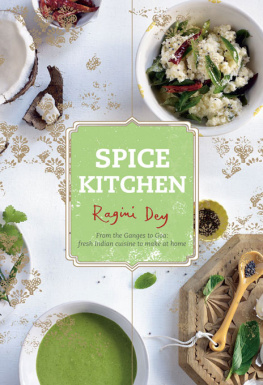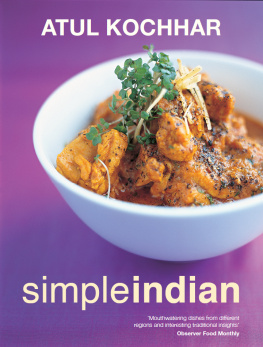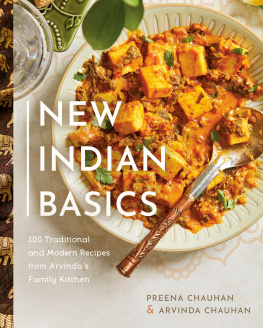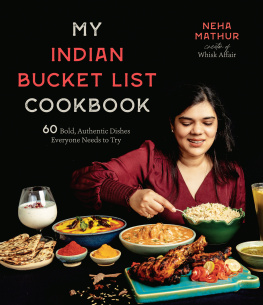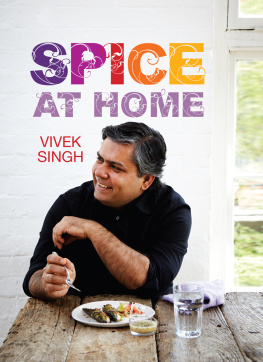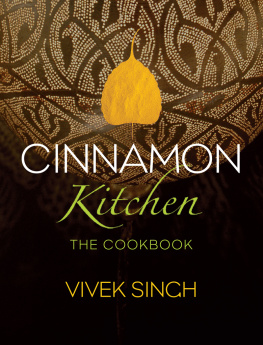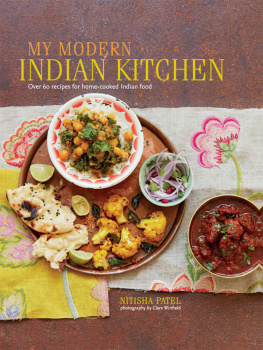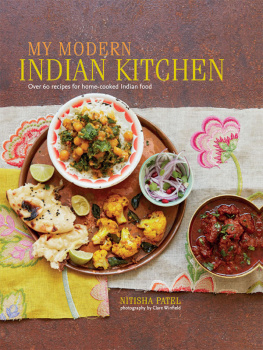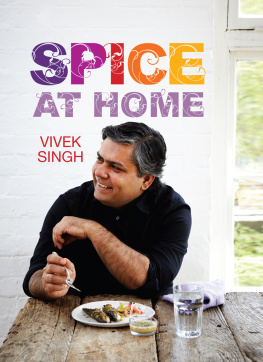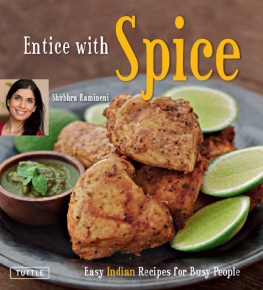CONTENTS
Indian food is vibrant, colourful and richly flavoured; described by some as both God-like in its purity, yet devilishly sly as its spices lie in wait for unsuspecting palates. Its cuisine has diversified and strengthened throughout history by all those who have come into contact with it: The Ancient Greeks brought lamb and the art of cheese-making, the early Mughals came looking for land, victory, melons and grapes, yet introduced korma, biryani and the tandoor. Their descendants, with a penchant for lavish banquets, embraced Indias spices, set up huge kitchen brigades, and helped develop the foundations of classical Indian cuisine. Under royal patronage, chefs experimented with different flavours and cooking styles, transforming ingredients to keep their masters interest. With the coming of the Portuguese, Indian food gained complexity and heat chillies, tomatoes and cashew nuts were all added to the Indian food repertoire. The arrival of the British Empire influenced Indian cuisine not with ingredients, but rather with new cooking techniques from English and French recipes.
Today, Indian food is truly global, influencing and being influenced by far-reaching corners of the world. Rustic meals, fine dining, street foods and regional specialties are all incorporated to make it one of the most exciting cuisines available.
My earliest food memories are of the family lunch table, specifically at my grandparents home, where plates of kababs, curries, sweet seasonal vegetables, crunchy salads, crumbly breads, beautiful rice dishes, perky aachars (pickles) and chutneys, softened by velvety raitas were consumed, while mothers and fathers, aunts and uncles compared their favourite recipes and tips for making the best parathas. Everyone had their own little story to tell, while us kids just tried to sneak in one more gulab jamun, hoping no one was watching. These recipes were handed down through the years, forever adapting with each new generation.
I believe I am very fortunate to have been brought up in an environment that not only explored the regional tastes of my own neighbourhood, but those of the entire country. My immediate family loved to travel, and each holiday was spent in a different part of India where I was encouraged to sample unique foods and regional specialties. As a result, my cooking has always been influenced by multi-regional flavours, many of which I have fine-tuned in my restaurant, and the resulting recipes can be seen in this book. Over the last twenty years at the Spice Kitchen, many of the more traditional recipes have gained star status by combining flavours of the north, south, east and west to produce innovative, multi-layered dishes that complement each other. You too can make up your own menu by pairing recipes from the various chapters in this book. Do not be constrained by regions and tradition, but instead be guided by the flavours and variety of dishes available.
Is Indian food difficult to cook? Not at all it is just a matter of learning the rules before breaking them! The recipes presented here are authentic and easy; some have an interesting twist, and all can be prepared with readily available ingredients.
To really enjoy your Indian meal, aim for a balance of meat and vegetable dishes, rich and simple, cooked and raw, hot and cold; accompanied by rice, bread, salad, chutneys and pickles. Alternatively, take advantage of the vast array of vegetarian dishes on offer one of the most distinctive elements of Indian cuisine is the predominance and importance of vegetarian food.
An Indian kitchen is a fragrant kitchen. The aroma of spices permeates every part of the body and soul, nourishing and satisfying the palate. Spices and herbs are the foundation blocks of all Indian cuisine, and are certainly not restricted to traditional curries. In Indian hands, roasts are redolent of ginger, onion, bay leaf, cardamom, black peppercorns and mustard, while a simple fried fish might be marinated with fresh coriander, chilli, garlic, ajwaiin seeds and mace. As with all good recipes, balance is the key. Nothing illustrates the less is more maxim better than the use of spices. Used individually, or in harmonious blends, spices bring perfection to any number of Indian dishes. On the other hand, there is nothing as terrible as a clumsily spiced dish with warring elements of sweet and bitter, or just muddied flavours. The careful blending of different spice quantities is always required to successfully achieve those few master dishes that use up to thirty-six spices.
Always start off with whole spices seeds, fruit or bark. They have much more flavour than powdered varieties. Dry-roast or heat whole spices before grinding using a mortar and pestle or electric spice grinder to release their maximum flavour and taste. Stay away from mass-produced pre-mixed curry powders and pastes; apart from everything tasting the same, you will never be able to duplicate the freshness and intensity achieved with freshly blended spices where subtlety shines through alongside bolder, more vibrant tastes.
Dont be afraid to try unfamiliar spices to get to know their distinctive flavours. For vegetables or delicately flavoured ingredients, use only one or two spices to bring out the taste, such as onion seeds and chilli with cauliflower, or mustard seeds with fish. Experiment with different combinations your imagination and taste buds will do the rest.
Here is a guide to twenty of the most important spices used in Indian cooking.
Ajwaiin Seeds:
These tiny grey seeds come from the same family as cumin and parsley. In taste, they are similar to celery seeds with overtones of thyme. In Indian cooking, they are used to flavour deep-fried foods, fish and vegetables. Try ajwaiin seeds stir-fried with garlic, prawns (shrimp) tomatoes, coriander (cilantro) leaves and chilli.
Allspice:
This berry comes from the Pimenta dioica, a small tree native to the West Indies. The fruit is gathered when green and unripe and dried in the sun, where the berries turn black. Allspice has the flavour of cloves, cinnamon and nutmeg. It is also known as Jamaica pepper, and in India as kababchini.
Amchur:
Green mangoes are dried and ground to obtain this sour tangy spice, used to lift the taste of popular snacks such as samosas and pakoras. Amchur is especially useful if you want to achieve a sour taste like lemon or tamarind without the liquid content.
Asafoetida:
A very sharp-tasting spice derived from a resinous gum of the fennel family, asafoetida is used sparingly in vegetarian dishes and with lentils. North Indian recipes, especially from Kashmir, include asafoetida but always in very minute amounts. The gum is said to aid digestion and gives a unique taste, which you may either love or hate. Its aroma after cooking has been compared with that of truffles. For a simple recipe, add a tiny amount to hot ghee with julienned ginger and fresh green peas.
Cardamom:
Also known as the Queen of Spices, cardamom is the fruit of a reed-like plant from the mountains near the Malabar Coast in India. Two types are commonly used in Indian cooking: the small and more delicate green cardamom pods with thin black seeds inside, and the large brown cardamom pods, which are at least four times the size of the green. The pods release a beautiful fragrance when crushed and the seeds have a strong, sweetish flavour. Cardamom is an essential ingredient of , and is often used to flavour sweet dishes such as custards, ice creams and rice puddings.

